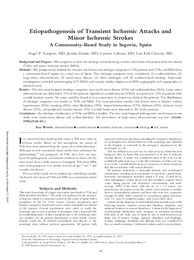Por favor, use este identificador para citar o enlazar este ítem:
https://hdl.handle.net/11000/30481Registro completo de metadatos
| Campo DC | Valor | Lengua/Idioma |
|---|---|---|
| dc.contributor.author | Perez-Sempere, Angel | - |
| dc.contributor.author | Duarte, Jacinto | - |
| dc.contributor.author | Cabezas, Carmen | - |
| dc.contributor.author | Clavería, Luis Erik | - |
| dc.contributor.other | Departamentos de la UMH::Medicina Clínica | es_ES |
| dc.date.accessioned | 2024-01-09T13:11:59Z | - |
| dc.date.available | 2024-01-09T13:11:59Z | - |
| dc.date.created | 1998-01 | - |
| dc.identifier.citation | Stroke January Vol 29, Issue 1 | es_ES |
| dc.identifier.issn | 1524-4628 | - |
| dc.identifier.issn | 0039-2499 | - |
| dc.identifier.uri | https://hdl.handle.net/11000/30481 | - |
| dc.description.abstract | Background and Purpose—We sought to analyze the etiology and underlying vascular risk factors of transient ischemic attacks (TIAs) and minor ischemic strokes (MISs). Methods—We prospectively studied the vascular risk factors and etiologic categories in 235 patients with TIAs and MISs from a community-based register in a rural area of Spain. Five etiologic categories were considered: (1) cardioembolism, (2) large-artery atherosclerosis, (3) small-artery disease, (4) other etiologies, and (5) undetermined etiology. Systematic investigations included neuroimaging (CT/MRI) and vascular studies (duplex scan/MR angiography and angiography in selected cases). Results—The two most frequent etiologic categories were small-artery disease (31%) and cardioembolism (26%). Large-artery atherosclerosis was detected in 11% of the patients. Significant carotid stenosis (≥50%) was present in 13% of patients with carotid territory events. No cause could be found or it was uncertain in almost one third of the patients. The distribution of etiologic categories was similar in TIAs and MISs. The most prevalent vascular risk factors were as follows: arterial hypertension (50%), smoking (26%), atrial fibrillation (20%), hypercholesterolemia (17%), diabetes (15%), ischemic heart disease (12%), and peripheral vascular disease (3%). Carotid bruits were detected in 3% of the patients. Conclusions—An etiologic classification of TIAs and MISs is feasible. The two most frequent pathogenetic mechanisms in our study were small-artery disease and cardioembolism. The prevalence of large-artery atherosclerosis was low. | es_ES |
| dc.format | application/pdf | es_ES |
| dc.format.extent | 6 | es_ES |
| dc.language.iso | eng | es_ES |
| dc.publisher | MD | es_ES |
| dc.rights | info:eu-repo/semantics/openAccess | es_ES |
| dc.rights.uri | http://creativecommons.org/licenses/by-nc-nd/4.0/ | * |
| dc.subject | atherosclerosis | es_ES |
| dc.subject | carotid arteries | es_ES |
| dc.subject | cerebral ischemia | es_ES |
| dc.subject | transient | es_ES |
| dc.subject | etiology | es_ES |
| dc.subject | risk factors | es_ES |
| dc.subject.other | CDU::6 - Ciencias aplicadas::61 - Medicina | es_ES |
| dc.title | Etiopathogenesis of Transient Ischemic Attacks and Minor Ischemic Strokes | es_ES |
| dc.type | info:eu-repo/semantics/article | es_ES |
| dc.relation.publisherversion | https://doi.org/10.1161/01.STR.29.1.40 | es_ES |

Ver/Abrir:
Stroke_EP.pdf
159,6 kB
Adobe PDF
Compartir:
 La licencia se describe como: Atribución-NonComercial-NoDerivada 4.0 Internacional.
La licencia se describe como: Atribución-NonComercial-NoDerivada 4.0 Internacional.
.png)